Related Research Articles

Pathology is the study of the causes and effects of disease or injury. The word pathology also refers to the study of disease in general, incorporating a wide range of biology research fields and medical practices. However, when used in the context of modern medical treatment, the term is often used in a narrower fashion to refer to processes and tests that fall within the contemporary medical field of "general pathology", an area which includes a number of distinct but inter-related medical specialties that diagnose disease, mostly through analysis of tissue and human cell samples. Idiomatically, "a pathology" may also refer to the predicted or actual progression of particular diseases, and the affix pathy is sometimes used to indicate a state of disease in cases of both physical ailment and psychological conditions. A physician practicing pathology is called a pathologist.
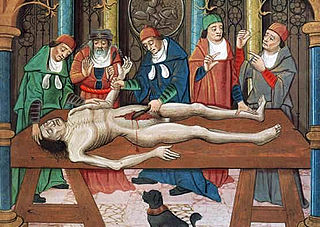
The history of anatomy extends from the earliest examinations of sacrificial victims to the sophisticated analyses of the body performed by modern anatomists and scientists. Written descriptions of human organs and parts can be traced back thousands of years to ancient Egyptian papyri, where attention to the body was necessitated by their highly elaborate burial practices.

Forensic pathology is pathology that focuses on determining the cause of death by examining a corpse. A post mortem examination is performed by a medical examiner or forensic pathologist, usually during the investigation of criminal law cases and civil law cases in some jurisdictions. Coroners and medical examiners are also frequently asked to confirm the identity of remains.
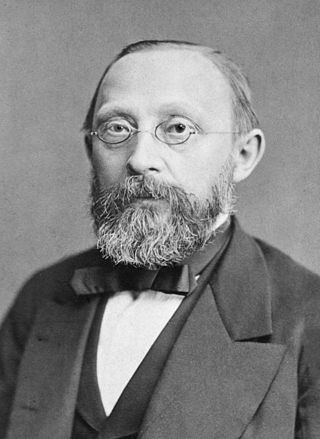
Rudolf Ludwig Carl Virchow was a German physician, anthropologist, pathologist, prehistorian, biologist, writer, editor, and politician. He is known as "the father of modern pathology" and as the founder of social medicine, and to his colleagues, the "Pope of medicine".

Herophilos, sometimes Latinised Herophilus, was a Greek physician regarded as one of the earliest anatomists. Born in Chalcedon, he spent the majority of his life in Alexandria. He was the first scientist to systematically perform scientific dissections of human cadavers. He recorded his findings in over nine works, which are now all lost. The early Christian author Tertullian states that Herophilos vivisected at least 600 live prisoners; however, this account has been disputed by many historians. He is often seen as the father of anatomy.

Erasistratus was a Greek anatomist and royal physician under Seleucus I Nicator of Syria. Along with fellow physician Herophilus, he founded a school of anatomy in Alexandria, where they carried out anatomical research. As well, he is credited with helping to found the methodic school of teachings of medicine in Alexandria whilst opposing traditional humoral theories of Hippocratic ideologies. Together with Herophilus, he is credited by historians as the potential founder of neuroscience due to his acknowledgements of nerves and their roles in motor control through the brain and skeletal muscles.
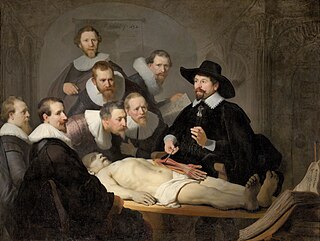
An autopsy is a surgical procedure that consists of a thorough examination of a corpse by dissection to determine the cause, mode, and manner of death; or the exam may be performed to evaluate any disease or injury that may be present for research or educational purposes. For animals, the term necropsy is generally reserved.
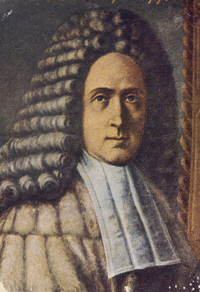
Giovanni Battista Morgagni was an Italian anatomist, generally regarded as the father of modern anatomical pathology, who taught thousands of medical students from many countries during his 56 years as Professor of Anatomy at the University of Padua.

Dissection is the dismembering of the body of a deceased animal or plant to study its anatomical structure. Autopsy is used in pathology and forensic medicine to determine the cause of death in humans. Less extensive dissection of plants and smaller animals preserved in a formaldehyde solution is typically carried out or demonstrated in biology and natural science classes in middle school and high school, while extensive dissections of cadavers of adults and children, both fresh and preserved are carried out by medical students in medical schools as a part of the teaching in subjects such as anatomy, pathology and forensic medicine. Consequently, dissection is typically conducted in a morgue or in an anatomy lab.

Baron Carl von Rokitansky was an Austrian Empire physician, pathologist, humanist philosopher and liberal politician, founder of the Viennese School of Medicine of the 19th century. Founder of science-based diagnostics.
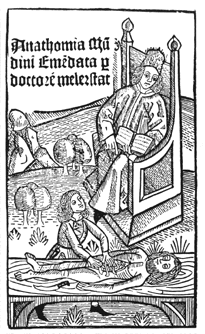
A prosector is a person with the special task of preparing a dissection for demonstration, usually in medical schools or hospitals. Many important anatomists began their careers as prosectors working for lecturers and demonstrators in anatomy and pathology.
Praxagoras was a figure of medicine in ancient Greece. He was born on the Greek island of Kos in about 340 BC. Both his father, Nicarchus, and his grandfather were physicians. Very little is known of Praxagoras' personal life, and none of his writings have survived.

Friedrich Daniel von Recklinghausen was a German pathologist born in Gütersloh, Westphalia. He was the father of physiologist Heinrich von Recklinghausen (1867–1942).
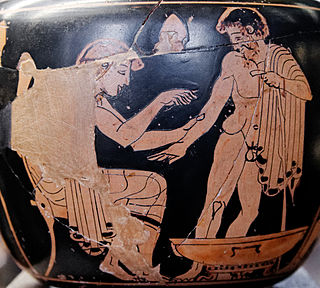
Ancient Greek medicine was a compilation of theories and practices that were constantly expanding through new ideologies and trials. The Greek term for medicine was iatrikē. Many components were considered in ancient Greek medicine, intertwining the spiritual with the physical. Specifically, the ancient Greeks believed health was affected by the humors, geographic location, social class, diet, trauma, beliefs, and mindset. Early on the ancient Greeks believed that illnesses were "divine punishments" and that healing was a "gift from the Gods". As trials continued wherein theories were tested against symptoms and results, the pure spiritual beliefs regarding "punishments" and "gifts" were replaced with a foundation based in the physical, i.e., cause and effect.
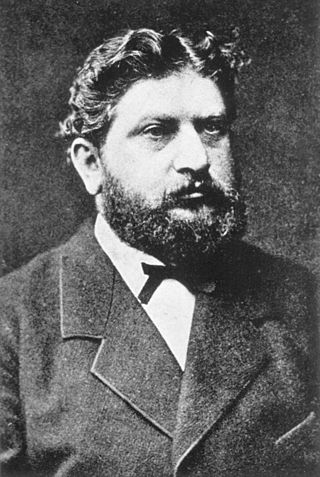
Julius Friedrich Cohnheim was a German-Jewish pathologist.
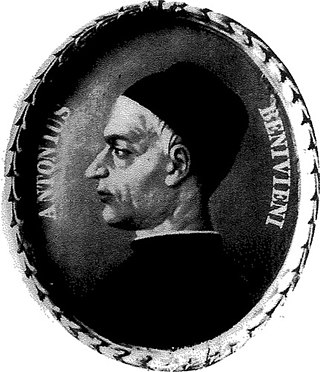
Antonio di Paolo Benivieni (1443–1502) was a Florentine physician who pioneered the use of the autopsy and many medical historians have considered him a founder of pathology.
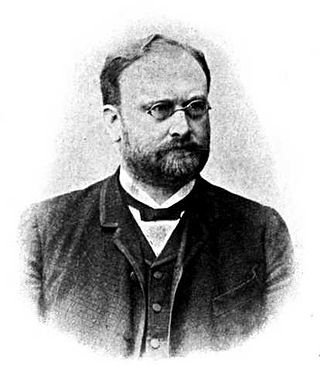
Johannes Orth was a German pathologist born in Wallmerod.
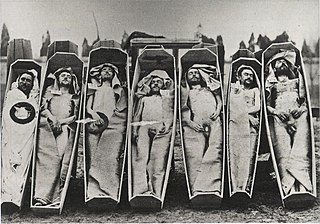
A cadaver or corpse is a dead human body. Cadavers are used by medical students, physicians and other scientists to study anatomy, identify disease sites, determine causes of death, and provide tissue to repair a defect in a living human being. Students in medical school study and dissect cadavers as a part of their education. Others who study cadavers include archaeologists and arts students. In addition, a cadaver may be used in the development and evaluation of surgical instruments.
References
- ↑ Von Staden, H (1992). "The discovery of the body: human dissection and its cultural contexts in ancient Greece". The Yale Journal of Biology and Medicine. 65 (3): 223–41. PMC 2589595 . PMID 1285450.
- ↑ Toby E. Huff (2003), The Rise of Early Modern Science: Islam, China, and the West, p. 54, 246-247, 216-218. Cambridge University Press, ISBN 0-521-52994-8.
- 1 2 3 4 5 History of Pathology, at the USC School of Dentistry
- ↑ Hippocrates: The Father of Spine Surgery : Spine
- ↑ Greek Medicine - Galen
- ↑ Medicine And Health, "Rise and Spread of Islam 622-1500: Science, Technology, Health", World Eras, Thomson Gale.
- ↑ Islamic medicine, Hutchinson Encyclopedia .
- ↑ Rubin's Pathology, Fifth Edition. 2008. Ed. R. Rubin and D.S. Strayer
- ↑ A History of Medicine from the Biblioteca Centrale dell'Area Biomedica
- ↑ Morgagni, GB (1903). "Founders of Modern Medicine: Giovanni Battista Morgagni. (1682-1771)". Medical Library and Historical Journal. 1 (4): 270–7. PMC 1698114 . PMID 18340813.
- ↑ Karl von Rokitansky at Whonamedit.com
- ↑ Rudolf Virchow at Whonamedit.com
- ↑ Jewish Encyclopedia entry on Julius Cohnheim
- ↑ "Mission and History". Archived from the original on 2008-05-12. Retrieved 2008-04-23. Mission of the American Society for Investigative Pathology
